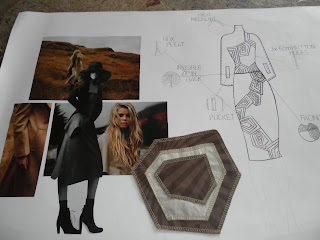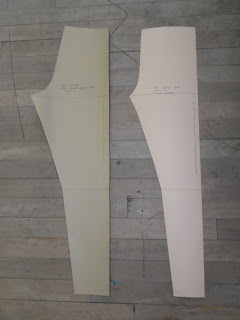
Saturday, 26 November 2011
TRICKY PART - THE APPLIQUE...

CREATING CUFFS FOR MY LEGGINGS...

CREATING A WAIST BAND FOR MY LEGGINGS...

Wednesday, 23 November 2011
CREATING A DESIGN WITH MY OWN TEMPLATE...

Saturday, 19 November 2011
2 DESIGN SHEETS COMPLETE JUST 4 MORE TO GO...


What do you guys think?
STARTING MY TOILE...
which was £5-99 a metre so was ideal to use for a Toile and the final leggings. I first started off by testing all the over lockers that were available to me to see which was the easiest to work with Lycra and the winner was in the Foundation Degree room. I then started by sewing the seams on the inner leg 1cm seam allowance up to the crotch area making sure all notches matched.Then I went onto sewing the crotch areas together matching them at the central notches with a 1cm seam allowance. Then I took it over to the mannequin and measured the waist to the stands size and realised it was about 2.5cm to big on both front and back so pinned it and took it in about 2cm from the front and back so it fitted. It still could do with a little bit more taken off but for now it's not such a big deal. That's all I managed to achieve from yesterday's lesson but I was working with stretch fabric so it took longer than expected.





CREATING MY BLOCKS AND PATTERNS FOR LEGGINGS...



Friday, 18 November 2011
DESIGN FOR LEONA LEWIS...
The link is:http://tlnt.at/rAQnZA
Thanks
Monday, 14 November 2011
LYCRA SAMPLES...

Which one do you think I should choose?
SAMPLING ON LYCRA...

Which one is your favourite?
TROUSERS 2 - SAMPLING...

Which do you prefer?
Thursday, 10 November 2011
TOBIE GIDDIO...

Tobie Giddio inspires my illustrative eye, as her illustrations are free and innovative using a lot of colour and thick brush strokes. With her ideas she focuses more on the form of the garment than the facial features of the model, which I think, works really effectively with the thicker outline still allowing it to be part of the composition. I think I will start to experiment with the use of colours on photo shop and illustrator and scanning in watercolour markings and shapes and providing them with a professional finish on a digital media. I could also use collage and layer different wet media to gain that contrast in texture. She has been highly inspired by Alexander McQueen using similar structures in her illustrations as he does in his designs. Her work reminds me of the 60s era with optical illusion references and block colours in repetitive patterns providing a wide range of colours. She also incorporates nature into her design but makes them more apparent and defined with thick bold lines and blocks of colour.
JEAN PIERRE BRAVAGANZA...
This Illustrator uses a mechanical pencil and white a4 paper mixed with a range of digital media conforming proportion to be slightly unbalanced within his figures. The mood of his work is quite eerie with the disturbing figures and contrast of values used contrasting to the mood of what Yohji Yamamoto create in his work. His style of work is quite characterised and cartoonist with the disproportionate fashion figures using solidified lines and pure colours. My opinion of this work is that it is a style I would like to use to convey my ideas as it offers a chance to create an identity which isn’t usually found in illustration and allows the design to stand out with the striking poses. The suitable market level would be for Ready to Wear, Couture with the use of clean lines and motion within the illustration.
I am inspired by his work, as it is different for the reason being that the proportions of the human form are inaccurate which make his compositions look effective. I also like how he sees the human form making the audience use their imagination to understand what target customer he is aiming his garments at and what story is behind his characters. I would experiment with similar medias of pencil and incorporate aspects of digital media and fine liner outlining the silhouettes and creating external shapes that coincide with his designs. Jean- Pierre Braganza has been inspired mostly by the human form and experiments with multiple shapes and pattern cutting methods to express every possibility. He uses a lot of black and organic fabrics in his design, which is evident in his illustrations bringing through parts of his garment design into his illustrative designs.
